1998 DODGE RAM 1500 AUX
[x] Cancel search: AUXPage 1631 of 2627
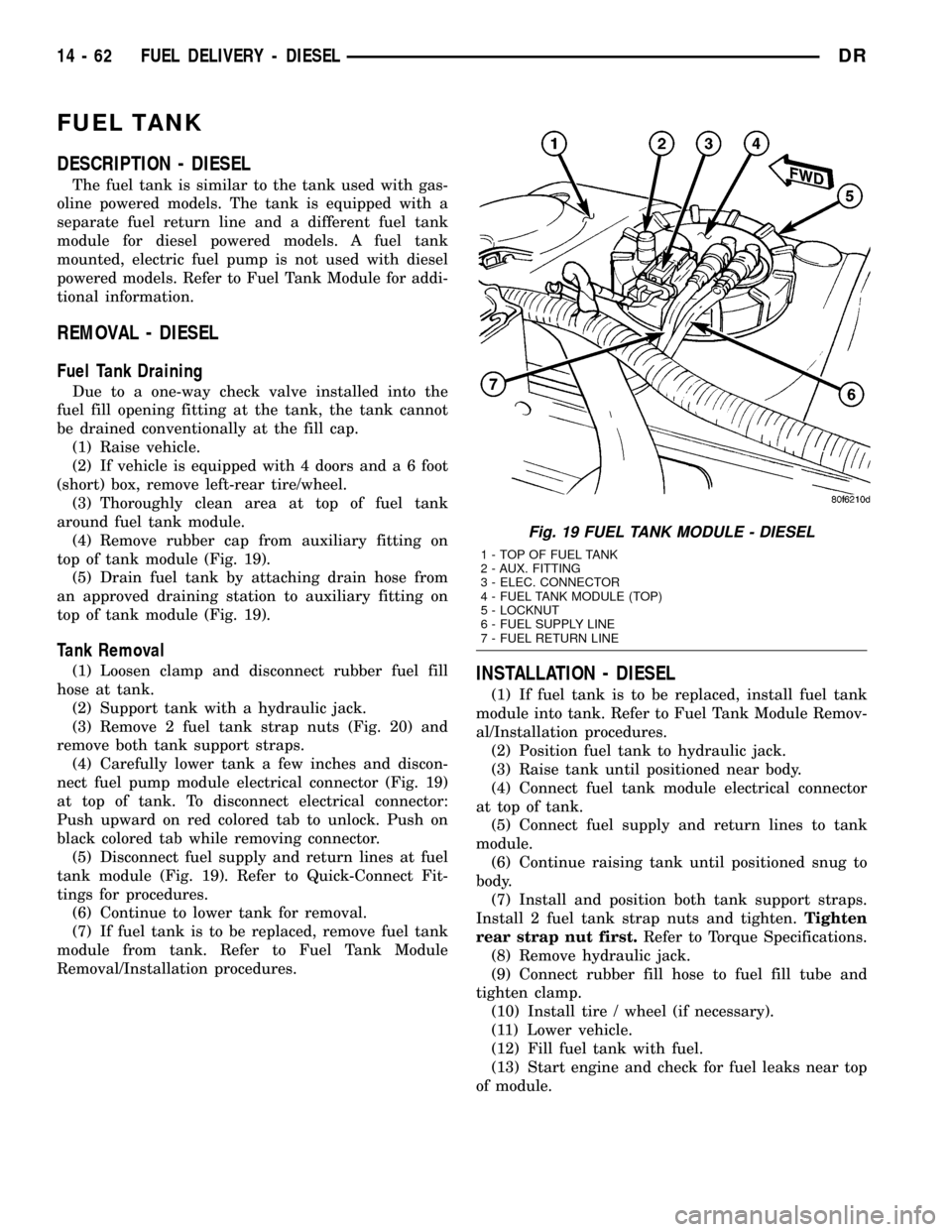
FUEL TANK
DESCRIPTION - DIESEL
The fuel tank is similar to the tank used with gas-
oline powered models. The tank is equipped with a
separate fuel return line and a different fuel tank
module for diesel powered models. A fuel tank
mounted, electric fuel pump is not used with diesel
powered models. Refer to Fuel Tank Module for addi-
tional information.
REMOVAL - DIESEL
Fuel Tank Draining
Due to a one-way check valve installed into the
fuel fill opening fitting at the tank, the tank cannot
be drained conventionally at the fill cap.
(1) Raise vehicle.
(2) If vehicle is equipped with 4 doors and a 6 foot
(short) box, remove left-rear tire/wheel.
(3) Thoroughly clean area at top of fuel tank
around fuel tank module.
(4) Remove rubber cap from auxiliary fitting on
top of tank module (Fig. 19).
(5) Drain fuel tank by attaching drain hose from
an approved draining station to auxiliary fitting on
top of tank module (Fig. 19).
Tank Removal
(1) Loosen clamp and disconnect rubber fuel fill
hose at tank.
(2) Support tank with a hydraulic jack.
(3) Remove 2 fuel tank strap nuts (Fig. 20) and
remove both tank support straps.
(4) Carefully lower tank a few inches and discon-
nect fuel pump module electrical connector (Fig. 19)
at top of tank. To disconnect electrical connector:
Push upward on red colored tab to unlock. Push on
black colored tab while removing connector.
(5) Disconnect fuel supply and return lines at fuel
tank module (Fig. 19). Refer to Quick-Connect Fit-
tings for procedures.
(6) Continue to lower tank for removal.
(7) If fuel tank is to be replaced, remove fuel tank
module from tank. Refer to Fuel Tank Module
Removal/Installation procedures.INSTALLATION - DIESEL
(1) If fuel tank is to be replaced, install fuel tank
module into tank. Refer to Fuel Tank Module Remov-
al/Installation procedures.
(2) Position fuel tank to hydraulic jack.
(3) Raise tank until positioned near body.
(4) Connect fuel tank module electrical connector
at top of tank.
(5) Connect fuel supply and return lines to tank
module.
(6) Continue raising tank until positioned snug to
body.
(7) Install and position both tank support straps.
Install 2 fuel tank strap nuts and tighten.Tighten
rear strap nut first.Refer to Torque Specifications.
(8) Remove hydraulic jack.
(9) Connect rubber fill hose to fuel fill tube and
tighten clamp.
(10) Install tire / wheel (if necessary).
(11) Lower vehicle.
(12) Fill fuel tank with fuel.
(13) Start engine and check for fuel leaks near top
of module.
Fig. 19 FUEL TANK MODULE - DIESEL
1 - TOP OF FUEL TANK
2 - AUX. FITTING
3 - ELEC. CONNECTOR
4 - FUEL TANK MODULE (TOP)
5 - LOCKNUT
6 - FUEL SUPPLY LINE
7 - FUEL RETURN LINE
14 - 62 FUEL DELIVERY - DIESELDR
Page 1632 of 2627
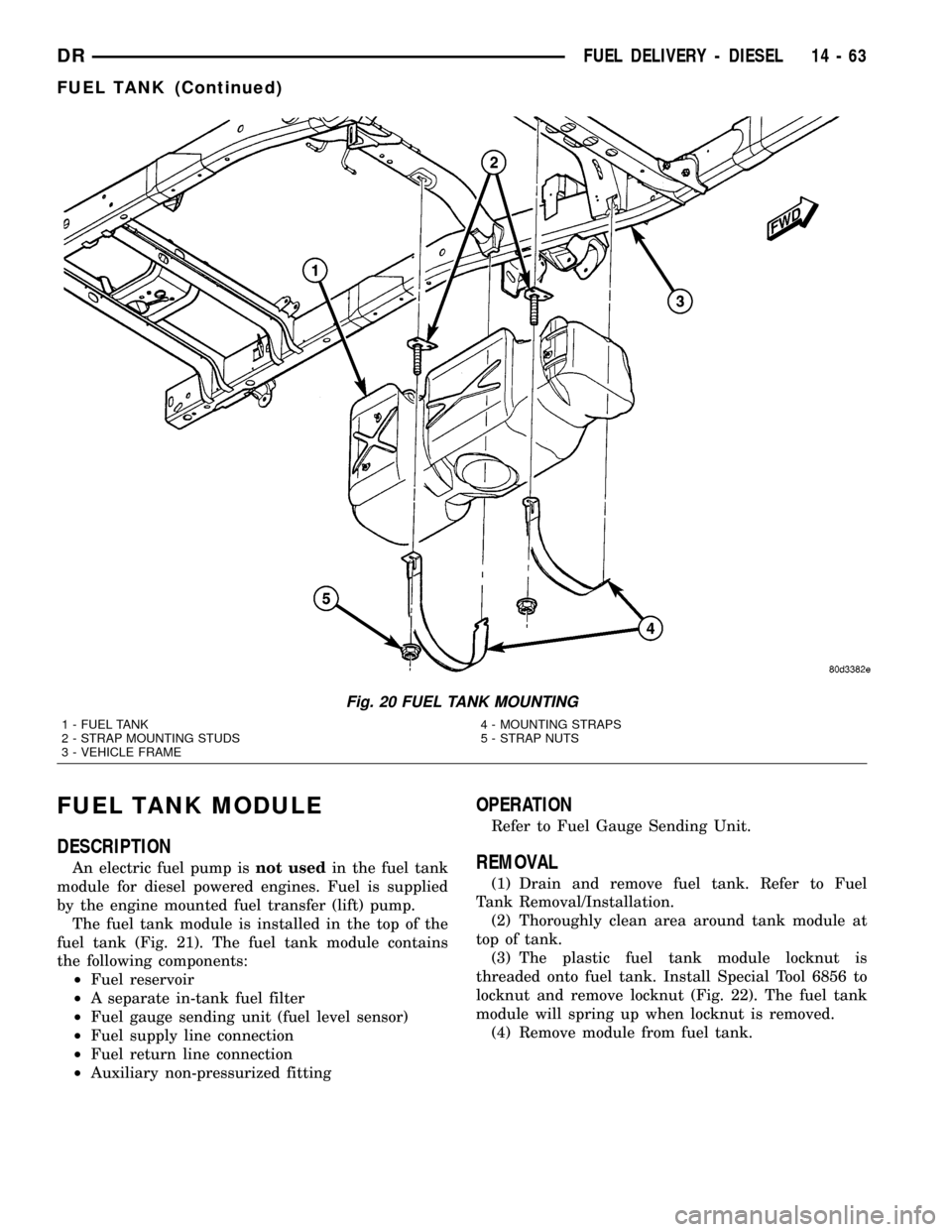
FUEL TANK MODULE
DESCRIPTION
An electric fuel pump isnot usedin the fuel tank
module for diesel powered engines. Fuel is supplied
by the engine mounted fuel transfer (lift) pump.
The fuel tank module is installed in the top of the
fuel tank (Fig. 21). The fuel tank module contains
the following components:
²Fuel reservoir
²A separate in-tank fuel filter
²Fuel gauge sending unit (fuel level sensor)
²Fuel supply line connection
²Fuel return line connection
²Auxiliary non-pressurized fitting
OPERATION
Refer to Fuel Gauge Sending Unit.
REMOVAL
(1) Drain and remove fuel tank. Refer to Fuel
Tank Removal/Installation.
(2) Thoroughly clean area around tank module at
top of tank.
(3) The plastic fuel tank module locknut is
threaded onto fuel tank. Install Special Tool 6856 to
locknut and remove locknut (Fig. 22). The fuel tank
module will spring up when locknut is removed.
(4) Remove module from fuel tank.
Fig. 20 FUEL TANK MOUNTING
1 - FUEL TANK
2 - STRAP MOUNTING STUDS
3 - VEHICLE FRAME4 - MOUNTING STRAPS
5 - STRAP NUTS
DRFUEL DELIVERY - DIESEL 14 - 63
FUEL TANK (Continued)
Page 1633 of 2627
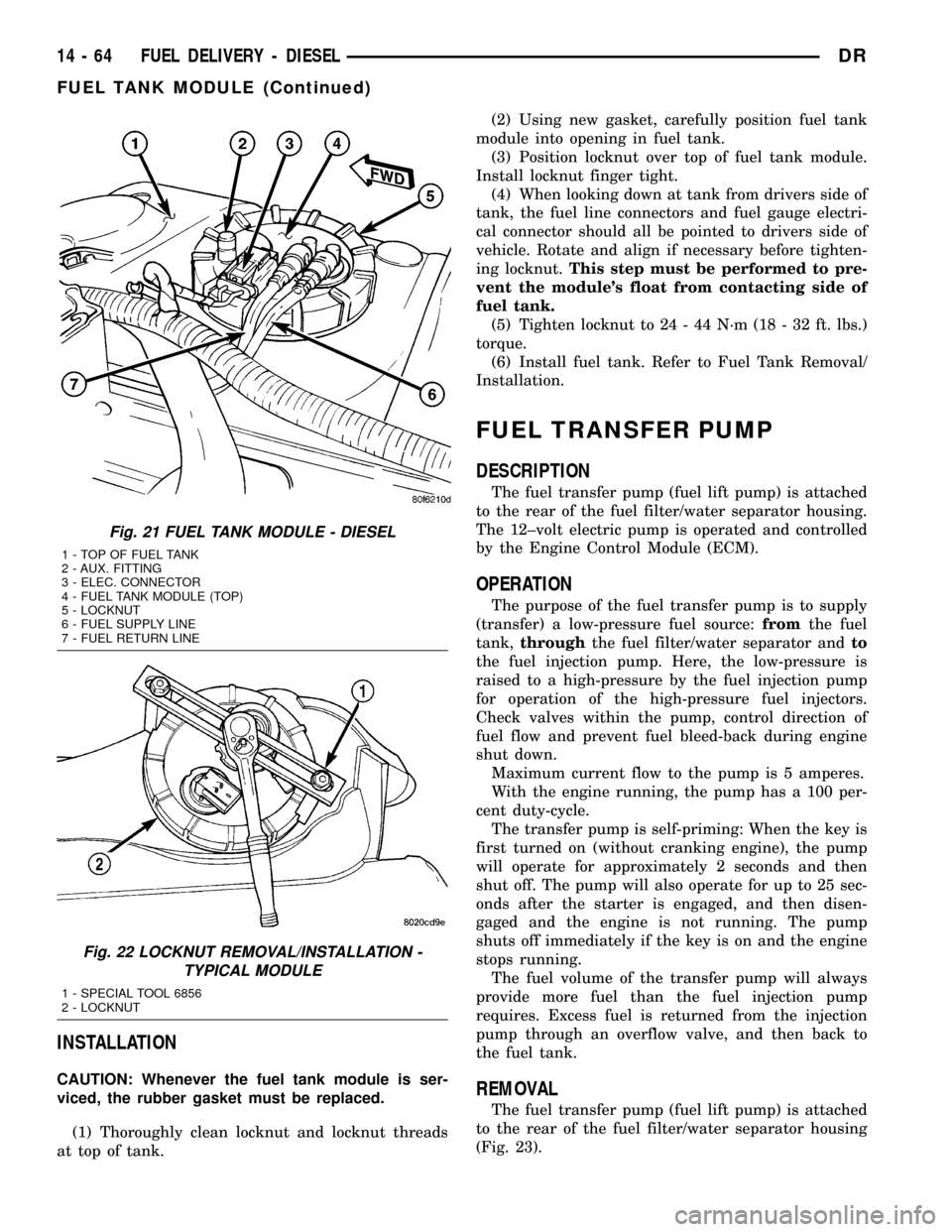
INSTALLATION
CAUTION: Whenever the fuel tank module is ser-
viced, the rubber gasket must be replaced.
(1) Thoroughly clean locknut and locknut threads
at top of tank.(2) Using new gasket, carefully position fuel tank
module into opening in fuel tank.
(3) Position locknut over top of fuel tank module.
Install locknut finger tight.
(4) When looking down at tank from drivers side of
tank, the fuel line connectors and fuel gauge electri-
cal connector should all be pointed to drivers side of
vehicle. Rotate and align if necessary before tighten-
ing locknut.This step must be performed to pre-
vent the module's float from contacting side of
fuel tank.
(5) Tighten locknut to 24 - 44 N´m (18 - 32 ft. lbs.)
torque.
(6) Install fuel tank. Refer to Fuel Tank Removal/
Installation.
FUEL TRANSFER PUMP
DESCRIPTION
The fuel transfer pump (fuel lift pump) is attached
to the rear of the fuel filter/water separator housing.
The 12±volt electric pump is operated and controlled
by the Engine Control Module (ECM).
OPERATION
The purpose of the fuel transfer pump is to supply
(transfer) a low-pressure fuel source:fromthe fuel
tank,throughthe fuel filter/water separator andto
the fuel injection pump. Here, the low-pressure is
raised to a high-pressure by the fuel injection pump
for operation of the high-pressure fuel injectors.
Check valves within the pump, control direction of
fuel flow and prevent fuel bleed-back during engine
shut down.
Maximum current flow to the pump is 5 amperes.
With the engine running, the pump has a 100 per-
cent duty-cycle.
The transfer pump is self-priming: When the key is
first turned on (without cranking engine), the pump
will operate for approximately 2 seconds and then
shut off. The pump will also operate for up to 25 sec-
onds after the starter is engaged, and then disen-
gaged and the engine is not running. The pump
shuts off immediately if the key is on and the engine
stops running.
The fuel volume of the transfer pump will always
provide more fuel than the fuel injection pump
requires. Excess fuel is returned from the injection
pump through an overflow valve, and then back to
the fuel tank.
REMOVAL
The fuel transfer pump (fuel lift pump) is attached
to the rear of the fuel filter/water separator housing
(Fig. 23).
Fig. 21 FUEL TANK MODULE - DIESEL
1 - TOP OF FUEL TANK
2 - AUX. FITTING
3 - ELEC. CONNECTOR
4 - FUEL TANK MODULE (TOP)
5 - LOCKNUT
6 - FUEL SUPPLY LINE
7 - FUEL RETURN LINE
Fig. 22 LOCKNUT REMOVAL/INSTALLATION -
TYPICAL MODULE
1 - SPECIAL TOOL 6856
2 - LOCKNUT
14 - 64 FUEL DELIVERY - DIESELDR
FUEL TANK MODULE (Continued)
Page 1904 of 2627
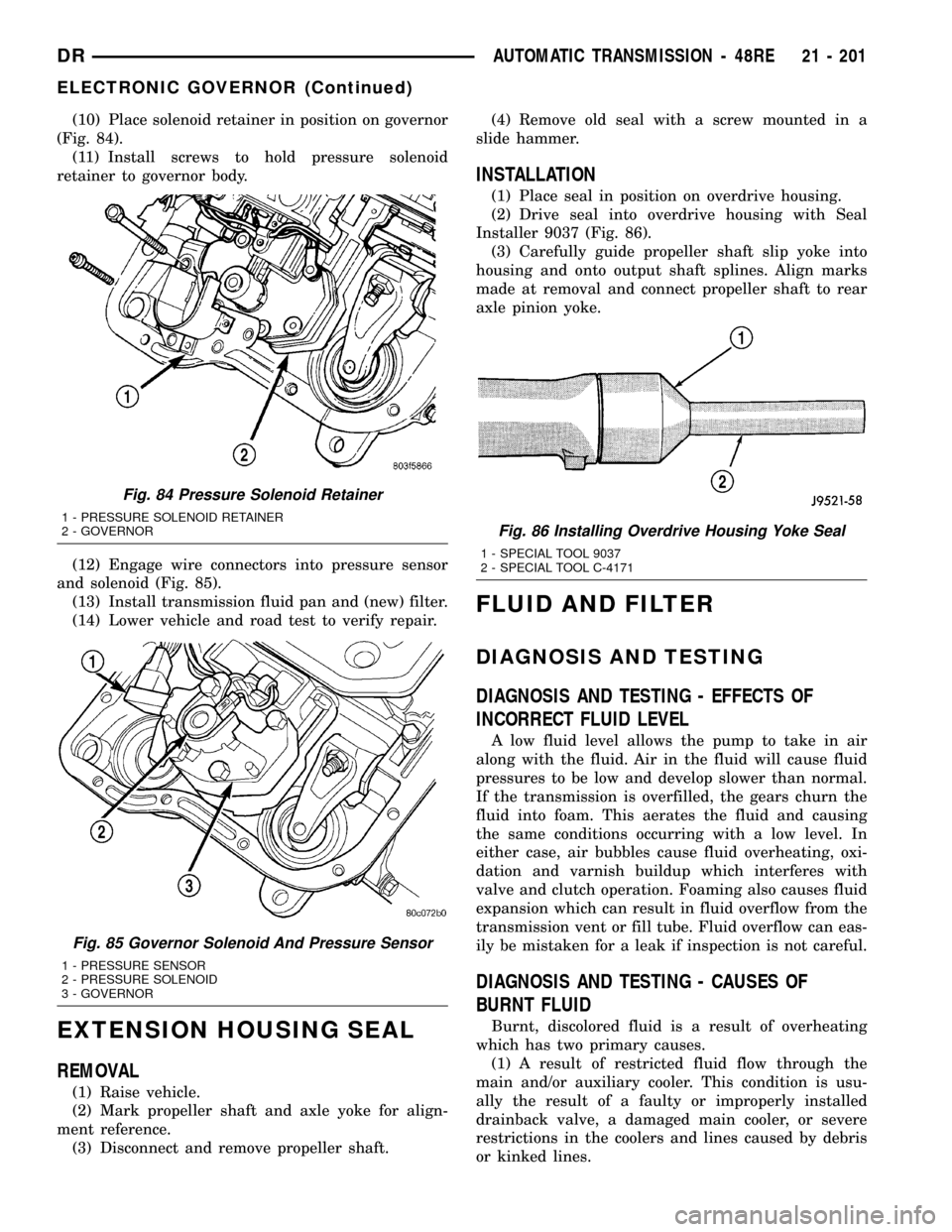
(10) Place solenoid retainer in position on governor
(Fig. 84).
(11) Install screws to hold pressure solenoid
retainer to governor body.
(12) Engage wire connectors into pressure sensor
and solenoid (Fig. 85).
(13) Install transmission fluid pan and (new) filter.
(14) Lower vehicle and road test to verify repair.
EXTENSION HOUSING SEAL
REMOVAL
(1) Raise vehicle.
(2) Mark propeller shaft and axle yoke for align-
ment reference.
(3) Disconnect and remove propeller shaft.(4) Remove old seal with a screw mounted in a
slide hammer.
INSTALLATION
(1) Place seal in position on overdrive housing.
(2) Drive seal into overdrive housing with Seal
Installer 9037 (Fig. 86).
(3) Carefully guide propeller shaft slip yoke into
housing and onto output shaft splines. Align marks
made at removal and connect propeller shaft to rear
axle pinion yoke.
FLUID AND FILTER
DIAGNOSIS AND TESTING
DIAGNOSIS AND TESTING - EFFECTS OF
INCORRECT FLUID LEVEL
A low fluid level allows the pump to take in air
along with the fluid. Air in the fluid will cause fluid
pressures to be low and develop slower than normal.
If the transmission is overfilled, the gears churn the
fluid into foam. This aerates the fluid and causing
the same conditions occurring with a low level. In
either case, air bubbles cause fluid overheating, oxi-
dation and varnish buildup which interferes with
valve and clutch operation. Foaming also causes fluid
expansion which can result in fluid overflow from the
transmission vent or fill tube. Fluid overflow can eas-
ily be mistaken for a leak if inspection is not careful.
DIAGNOSIS AND TESTING - CAUSES OF
BURNT FLUID
Burnt, discolored fluid is a result of overheating
which has two primary causes.
(1) A result of restricted fluid flow through the
main and/or auxiliary cooler. This condition is usu-
ally the result of a faulty or improperly installed
drainback valve, a damaged main cooler, or severe
restrictions in the coolers and lines caused by debris
or kinked lines.
Fig. 84 Pressure Solenoid Retainer
1 - PRESSURE SOLENOID RETAINER
2 - GOVERNOR
Fig. 85 Governor Solenoid And Pressure Sensor
1 - PRESSURE SENSOR
2 - PRESSURE SOLENOID
3 - GOVERNOR
Fig. 86 Installing Overdrive Housing Yoke Seal
1 - SPECIAL TOOL 9037
2 - SPECIAL TOOL C-4171
DRAUTOMATIC TRANSMISSION - 48RE 21 - 201
ELECTRONIC GOVERNOR (Continued)
Page 1905 of 2627
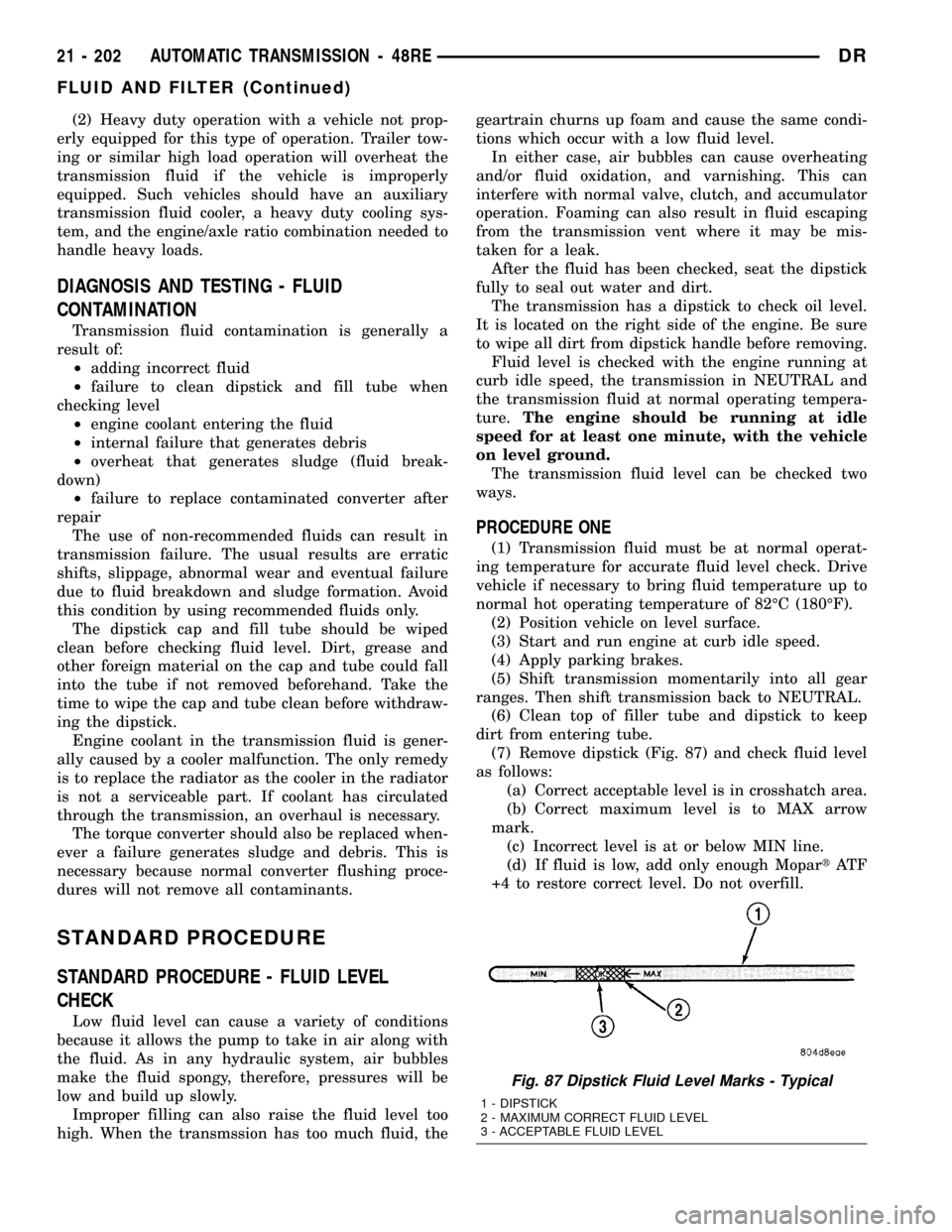
(2) Heavy duty operation with a vehicle not prop-
erly equipped for this type of operation. Trailer tow-
ing or similar high load operation will overheat the
transmission fluid if the vehicle is improperly
equipped. Such vehicles should have an auxiliary
transmission fluid cooler, a heavy duty cooling sys-
tem, and the engine/axle ratio combination needed to
handle heavy loads.
DIAGNOSIS AND TESTING - FLUID
CONTAMINATION
Transmission fluid contamination is generally a
result of:
²adding incorrect fluid
²failure to clean dipstick and fill tube when
checking level
²engine coolant entering the fluid
²internal failure that generates debris
²overheat that generates sludge (fluid break-
down)
²failure to replace contaminated converter after
repair
The use of non-recommended fluids can result in
transmission failure. The usual results are erratic
shifts, slippage, abnormal wear and eventual failure
due to fluid breakdown and sludge formation. Avoid
this condition by using recommended fluids only.
The dipstick cap and fill tube should be wiped
clean before checking fluid level. Dirt, grease and
other foreign material on the cap and tube could fall
into the tube if not removed beforehand. Take the
time to wipe the cap and tube clean before withdraw-
ing the dipstick.
Engine coolant in the transmission fluid is gener-
ally caused by a cooler malfunction. The only remedy
is to replace the radiator as the cooler in the radiator
is not a serviceable part. If coolant has circulated
through the transmission, an overhaul is necessary.
The torque converter should also be replaced when-
ever a failure generates sludge and debris. This is
necessary because normal converter flushing proce-
dures will not remove all contaminants.
STANDARD PROCEDURE
STANDARD PROCEDURE - FLUID LEVEL
CHECK
Low fluid level can cause a variety of conditions
because it allows the pump to take in air along with
the fluid. As in any hydraulic system, air bubbles
make the fluid spongy, therefore, pressures will be
low and build up slowly.
Improper filling can also raise the fluid level too
high. When the transmssion has too much fluid, thegeartrain churns up foam and cause the same condi-
tions which occur with a low fluid level.
In either case, air bubbles can cause overheating
and/or fluid oxidation, and varnishing. This can
interfere with normal valve, clutch, and accumulator
operation. Foaming can also result in fluid escaping
from the transmission vent where it may be mis-
taken for a leak.
After the fluid has been checked, seat the dipstick
fully to seal out water and dirt.
The transmission has a dipstick to check oil level.
It is located on the right side of the engine. Be sure
to wipe all dirt from dipstick handle before removing.
Fluid level is checked with the engine running at
curb idle speed, the transmission in NEUTRAL and
the transmission fluid at normal operating tempera-
ture.The engine should be running at idle
speed for at least one minute, with the vehicle
on level ground.
The transmission fluid level can be checked two
ways.
PROCEDURE ONE
(1) Transmission fluid must be at normal operat-
ing temperature for accurate fluid level check. Drive
vehicle if necessary to bring fluid temperature up to
normal hot operating temperature of 82ÉC (180ÉF).
(2) Position vehicle on level surface.
(3) Start and run engine at curb idle speed.
(4) Apply parking brakes.
(5) Shift transmission momentarily into all gear
ranges. Then shift transmission back to NEUTRAL.
(6) Clean top of filler tube and dipstick to keep
dirt from entering tube.
(7) Remove dipstick (Fig. 87) and check fluid level
as follows:
(a) Correct acceptable level is in crosshatch area.
(b) Correct maximum level is to MAX arrow
mark.
(c) Incorrect level is at or below MIN line.
(d) If fluid is low, add only enough MopartAT F
+4 to restore correct level. Do not overfill.
Fig. 87 Dipstick Fluid Level Marks - Typical
1 - DIPSTICK
2 - MAXIMUM CORRECT FLUID LEVEL
3 - ACCEPTABLE FLUID LEVEL
21 - 202 AUTOMATIC TRANSMISSION - 48REDR
FLUID AND FILTER (Continued)
Page 2069 of 2627

FLUID AND FILTER
DIAGNOSIS AND TESTING
DIAGNOSIS AND TESTING - EFFECTS OF
INCORRECT FLUID LEVEL
A low fluid level allows the pump to take in air
along with the fluid. Air in the fluid will cause fluid
pressures to be low and develop slower than normal.
If the transmission is overfilled, the gears churn the
fluid into foam. This aerates the fluid and causing
the same conditions occurring with a low level. In
either case, air bubbles cause fluid overheating, oxi-
dation and varnish buildup which interferes with
valve and clutch operation. Foaming also causes fluid
expansion which can result in fluid overflow from the
transmission vent or fill tube. Fluid overflow can eas-
ily be mistaken for a leak if inspection is not careful.
DIAGNOSIS AND TESTING - CAUSES OF
BURNT FLUID
Burnt, discolored fluid is a result of overheating
which has three primary causes.
(1) Internal clutch slippage, usually caused by low
line pressure, inadequate clutch apply pressure, or
clutch seal failure.
(2) A result of restricted fluid flow through the
main and/or auxiliary cooler. This condition is usu-
ally the result of a faulty or improperly installed
drainback valve, a damaged main cooler, or severe
restrictions in the coolers and lines caused by debris
or kinked lines.
(3) Heavy duty operation with a vehicle not prop-
erly equipped for this type of operation. Trailer tow-
ing or similar high load operation will overheat the
transmission fluid if the vehicle is improperly
equipped. Such vehicles should have an auxiliary
transmission fluid cooler, a heavy duty cooling sys-
tem, and the engine/axle ratio combination needed to
handle heavy loads.
DIAGNOSIS AND TESTING - FLUID
CONTAMINATION
Transmission fluid contamination is generally a
result of:
²adding incorrect fluid
²failure to clean dipstick and fill tube when
checking level
²engine coolant entering the fluid
²internal failure that generates debris
²overheat that generates sludge (fluid break-
down)
²failure to replace contaminated converter after
repairThe use of non-recommended fluids can result in
transmission failure. The usual results are erratic
shifts, slippage, abnormal wear and eventual failure
due to fluid breakdown and sludge formation. Avoid
this condition by using recommended fluids only.
The dipstick cap and fill tube should be wiped
clean before checking fluid level. Dirt, grease and
other foreign material on the cap and tube could fall
into the tube if not removed beforehand. Take the
time to wipe the cap and tube clean before withdraw-
ing the dipstick.
Engine coolant in the transmission fluid is gener-
ally caused by a cooler malfunction. The only remedy
is to replace the radiator as the cooler in the radiator
is not a serviceable part. If coolant has circulated
through the transmission, an overhaul is necessary.
The torque converter should also be replaced when-
ever a failure generates sludge and debris. This is
necessary because normal converter flushing proce-
dures will not remove all contaminants.
STANDARD PROCEDURE
STANDARD PROCEDURE - FLUID LEVEL
CHECK
Low fluid level can cause a variety of conditions
because it allows the pump to take in air along with
the fluid. As in any hydraulic system, air bubbles
make the fluid spongy, therefore, pressures will be
low and build up slowly.
Improper filling can also raise the fluid level too
high. When the transmssion has too much fluid, the
geartrain churns up foam and cause the same condi-
tions which occur with a low fluid level.
In either case, air bubbles can cause overheating
and/or fluid oxidation, and varnishing. This can
interfere with normal valve, clutch, and accumulator
operation. Foaming can also result in fluid escaping
from the transmission vent where it may be mis-
taken for a leak.
After the fluid has been checked, seat the dipstick
fully to seal out water and dirt.
The transmission has a dipstick to check oil level.
It is located on the right side of the engine. Be sure
to wipe all dirt from dipstick handle before removing.
The torque converter fills in both the P (PARK)
and N (NEUTRAL) positions. Place the selector lever
in P (PARK) to be sure that the fluid level check is
accurate.The engine should be running at idle
speed for at least one minute, with the vehicle
on level ground.At normal operating temperature
(approximately 82 C. or 180 F.), the fluid level is cor-
rect if it is in the HOT region (cross-hatched area) on
the oil level indicator. The fluid level will be approx-
21 - 366 AUTOMATIC TRANSMISSION - 45RFE/545RFEDR
Page 2589 of 2627

AIRBAG INDICATOR - OPERATION.......8J-18
AIRBAG ON/OFF SWITCH -
DESCRIPTION, PASSENGER............8O-42
AIRBAG ON/OFF SWITCH -
INSTALLATION, PASSENGER...........8O-44
AIRBAG ON/OFF SWITCH - OPERATION,
PASSENGER........................8O-43
AIRBAG ON/OFF SWITCH - REMOVAL,
PASSENGER........................8O-43
AJAR INDICATOR - DESCRIPTION, DOOR . . 8J-23
AJAR INDICATOR - OPERATION, DOOR . . . 8J-23
AJAR SWITCH - DESCRIPTION, DOOR....8L-27
AJAR SWITCH - OPERATION, DOOR......8L-27
ALIGNMENT - DESCRIPTION, WHEEL.......2-1
ALIGNMENT - OPERATION, WHEEL........2-2
ALIGNMENT LINK/COIL SUSPENSION -
STANDARD PROCEDURE.................2-5
ALIGNMENT, SPECIAL TOOLS - WHEEL.....2-7
ALIGNMENT, SPECIFICATIONS............2-6
ALUMINUM THREAD REPAIR -
STANDARD PROCEDURE........21-158,21-318
AMBIENT TEMP SENSOR - DESCRIPTION . 8M-10
AMBIENT TEMP SENSOR - OPERATION . . 8M-10
AMBIENT TEMPERATURE SENSOR -
DIAGNOSIS AND TESTING.............8M-10
AMBIENT TEMPERATURE SENSOR
CIRCUIT - DIAGNOSIS AND TESTING....8M-10
AMPLIFIER - DESCRIPTION.............8A-3
AMPLIFIER - INSTALLATION.............8A-4
AMPLIFIER - OPERATION...............8A-3
AMPLIFIER - REMOVAL................8A-3
ANCHOR - DESCRIPTION, CHILD
RESTRAINT.........................8O-15
ANCHOR - INSTALLATION, CHILD
RESTRAINT.........................8O-18
ANCHOR - OPERATION, CHILD
RESTRAINT.........................8O-17
ANCHOR - REMOVAL, CHILD RESTRAINT . 8O-17
ANCHOR & RIGHT OUTBOARD -
INSTALLATION, CENTER...............8O-50
ANCHOR & RIGHT OUTBOARD -
REMOVAL, CENTER...................8O-49
ANTENNA - NAVIGATION -
INSTALLATION.......................8A-6
ANTENNA - NAVIGATION - REMOVAL......8A-6
ANTENNA BODY & CABLE -
DESCRIPTION........................8A-4
ANTENNA BODY & CABLE -
INSTALLATION.......................8A-6
ANTENNA BODY & CABLE - OPERATION . . . 8A-4
ANTENNA BODY & CABLE - REMOVAL.....8A-6
ANTENNA BODY AND CABLE -
DIAGNOSIS AND TESTING..............8A-4
ANTENNA CABLE - INSTALLATION,
INSTRUMENT PANEL..................8A-7
ANTENNA CABLE - REMOVAL,
INSTRUMENT PANEL..................8A-7
ANTILOCK - DIAGNOSIS AND TESTING,
REAR WHEEL........................5-48
ANTILOCK BRAKE - DESCRIPTION,
CONTROLLER........................8E-3
ANTILOCK BRAKE - INSTALLATION,
CONTROLLER
........................8E-3
ANTILOCK BRAKE - OPERATION,
CONTROLLER
........................8E-3
ANTILOCK BRAKE - REMOVAL,
CONTROLLER
........................8E-3
A-PILLAR TRIM/GRAB HANDLE -
INSTALLATION
.......................23-63
A-PILLAR TRIM/GRAB HANDLE -
REMOVAL
..........................23-63
A-PILLAR WEATHERSTRIP RETAINER -
INSTALLATION
.......................23-91
A-PILLAR WEATHERSTRIP RETAINER -
REMOVAL
..........................23-91
AREA LEAKS - DIAGNOSIS AND
TESTING, REAR SEAL
........9-137,9-209,9-65
ARM / ADJUSTER ASSEMBLY -
DESCRIPTION, ROCKER
...............9-125
ARM / ADJUSTER ASSEMBLY -
INSTALLATION, ROCKER
...............9-126
ARM / ADJUSTER ASSEMBLY -
REMOVAL, ROCKER
..................9-126
ARM / ADJUSTER ASSY - CLEANING,
ROCKER
............................9-262
ARM / ADJUSTER ASSY - DESCRIPTION,
ROCKER
............................9-261ARM / ADJUSTER ASSY - INSPECTION,
ROCKER............................9-262
ARM / ADJUSTER ASSY -
INSTALLATION, ROCKER..........9-203,9-263
ARM / ADJUSTER ASSY - REMOVAL,
ROCKER......................9-203,9-261
ARM - DESCRIPTION, ROCKER......9-31,9-37
ARM - DESCRIPTION, WIPER...........8R-17
ARM - INSTALLATION, LOWER
SUSPENSION.........................2-38
ARM - INSTALLATION, PITMAN.........19-37
ARM - INSTALLATION, ROCKER..........9-31
ARM - INSTALLATION, UPPER CONTROL . . . 2-28
ARM - INSTALLATION, WIPER..........8R-18
ARM - OPERATION, WIPER............8R-18
ARM - REMOVAL, LOWER SUSPENSION . . . 2-38
ARM - REMOVAL, PITMAN.............19-36
ARM - REMOVAL, ROCKER..........9-31,9-37
ARM - REMOVAL, UPPER CONTROL......2-28
ARM - REMOVAL, WIPER..............8R-18
ARM BUSHINGS - 2WD (LD) -
INSTALLATION, LOWER CONTROL........2-15
ARM BUSHINGS - 2WD (LD) -
REMOVAL, LOWER CONTROL............2-13
ARM BUSHINGS - 4WD (LD) -
INSTALLATION, LOWER CONTROL........2-14
ARM BUSHINGS - 4WD (LD) -
REMOVAL, LOWER CONTROL............2-13
ARMREST / SEAT BACK - INSTALLATION,
CENTER.............................23-77
ARMREST / SEAT BACK - REMOVAL,
CENTER............................23-76
ASD AND FUEL PUMP RELAYS -
DIAGNOSIS AND TESTING...............8I-5
ASD SENSE - PCM INPUT - OPERATION....8I-5
ASH RECEIVER - INSTALLATION.........23-51
ASH RECEIVER - REMOVAL............23-50
AUDIO - DESCRIPTION.................8A-1
AUDIO - DIAGNOSIS AND TESTING.......8A-2
AUDIO - OPERATION...................8A-1
AUTOMATIC DAY / NIGHT MIRROR -
DESCRIPTION.......................8N-11
AUTOMATIC DAY / NIGHT MIRROR -
DIAGNOSIS AND TESTING.............8N-11
AUTOMATIC DAY / NIGHT MIRROR -
OPERATION.........................8N-11
AUTOMATIC DAY / NIGHT MIRROR -
REMOVAL..........................8N-12
AUTOMATIC LOCKING RETRACTOR -
DESCRIPTION.......................8O-14
AUTOMATIC LOCKING RETRACTOR -
OPERATION.........................8O-14
AUTOMATIC TRANSMISSION -
45RFE/545RFE - DESCRIPTION.........21-312
AUTOMATIC TRANSMISSION -
45RFE/545RFE - OPERATION...........21-313
AUTOMATIC TRANSMISSION - 48RE -
DESCRIPTION......................21-132
AUTOMATIC TRANSMISSION - 48RE -
OPERATION........................21-134
AUTOMATIC TRANSMISSION -
DIAGNOSIS AND TESTING......21-140,21-314
AUTOMATIC TRANSMISSION FLUID -
DESCRIPTION.........................0-4
AUTOMATIC TRANSMISSION FLUID -
OPERATION...........................0-5
AUXILIARY SPRING BUMPERS (3500) -
INSTALLATION........................2-43
AUXILIARY SPRING BUMPERS (3500) -
REMOVAL...........................2-43
AXLE - 10 1/2 AA - ADJUSTMENTS,
REAR..............................3-116
AXLE - 10 1/2 AA - DIAGNOSIS AND
TESTING, REAR......................3-112
AXLE - 10 1/2 AA - INSTALLATION,
REAR..............................3-116
AXLE - 10 1/2 AA - REMOVAL, REAR.....3-115
AXLE - 10 1/2 AA - SPECIAL TOOLS,
REAR..............................3-120
AXLE - 10 1/2 AA - SPECIFICATIONS,
REAR
..............................3-120
AXLE - 11 1/2 AA - ADJUSTMENTS,
REAR
..............................3-144
AXLE - 11 1/2 AA - DIAGNOSIS AND
TESTING, REAR
......................3-140
AXLE - 11 1/2 AA - INSTALLATION,
REAR
..............................3-144
AXLE - 11 1/2 AA - REMOVAL, REAR
.....3-143AXLE - 11 1/2 AA - SPECIAL TOOLS,
REAR..............................3-148
AXLE - 11 1/2 AA - SPECIFICATIONS,
REAR..............................3-148
AXLE - 9 1/4 - ADJUSTMENTS, REAR.....3-83
AXLE - 9 1/4 - DIAGNOSIS AND
TESTING, REAR.......................3-80
AXLE - 9 1/4 - INSTALLATION, REAR......3-83
AXLE - 9 1/4 - REMOVAL, REAR..........3-83
AXLE - 9 1/4 - SPECIAL TOOLS, REAR.....3-90
AXLE - 9 1/4 - SPECIFICATIONS, REAR....3-90
AXLE - 9 1/4 AA - ADJUSTMENTS,
FRONT..............................3-59
AXLE - 9 1/4 AA - DIAGNOSIS AND
TESTING, FRONT......................3-54
AXLE - 9 1/4 AA - INSTALLATION,
FRONT..............................3-58
AXLE - 9 1/4 AA - REMOVAL, FRONT......3-57
AXLE - 9 1/4 AA - SPECIAL TOOLS,
FRONT..............................3-64
AXLE - 9 1/4 AA - SPECIFICATIONS,
FRONT..............................3-63
AXLE - C205F - ADJUSTMENTS, FRONT....3-32
AXLE - C205F - DIAGNOSIS AND
TESTING, FRONT......................3-27
AXLE - C205F - INSTALLATION, FRONT....3-31
AXLE - C205F - REMOVAL, FRONT........3-31
AXLE - C205F - SPECIAL TOOLS, FRONT . . . 3-40
AXLE - C205F - SPECIFICATIONS, FRONT . . . 3-39
AXLE - DESCRIPTION.....................0-4
AXLE BEARINGS - INSTALLATION . . 3-125,3-153,
3-44,3-95
AXLE BEARINGS - REMOVAL . . 3-125,3-152,3-43,
3-95
AXLE SHAFT SEALS - INSTALLATION . 3-43,3-70,
3-94
AXLE SHAFT SEALS - REMOVAL . 3-43,3-69,3-94
AXLE SHAFTS - ASSEMBLY.............3-69
AXLE SHAFTS - DISASSEMBLY...........3-68
AXLE SHAFTS - INSTALLATION....3-124,3-152,
3-43,3-69,3-94
AXLE SHAFTS - REMOVAL....3-124,3-152,3-43,
3-67,3-93
BACK - INSTALLATION, CENTER
ARMREST / SEAT....................23-77
BACK - REAR - INSTALLATION, SEAT.....23-83
BACK - REAR - REMOVAL, SEAT........23-83
BACK - REMOVAL, CENTER ARMREST /
SEAT ..............................23-76
BACK CUSHION / COVER - FRONT -
INSTALLATION, SEAT.................23-82
BACK CUSHION / COVER - FRONT -
REMOVAL, SEAT.....................23-82
BACK CUSHION / COVER - REAR -
INSTALLATION, SEAT.................23-84
BACK CUSHION / COVER - REAR -
REMOVAL, SEAT.....................23-84
BACK HINGE - INSTALLATION, CENTER
SEAT ..............................23-79
BACK HINGE - REMOVAL, CENTER SEAT . . 23-78
BACK INERTIA HINGE COVER -
INSTALLATION, CENTER SEAT..........23-77
BACK INERTIA HINGE COVER -
REMOVAL, CENTER SEAT..............23-77
BACK LID - INSTALLATION, CENTER
SEAT ..............................23-79
BACK LID - REMOVAL, CENTER SEAT....23-79
BACK PANEL TRIM - INSTALLATION,
REAR CAB..........................23-69
BACK PANEL TRIM - REMOVAL, REAR
CAB
...............................23-68
BACK REAR - FOOTMANS LOOP
BRACKETS - INSTALLATION, SEAT
.......23-85
BACK REAR - FOOTMANS LOOP
BRACKETS - REMOVAL, SEAT
...........23-85
BACKLITE - INSTALLATION
.............23-86
BACKLITE - REMOVAL
.................23-86
BACKLITE VENT GLASS - INSTALLATION
. . 23-87
BACKLITE VENT GLASS - REMOVAL
......23-87
BACKUP LAMP SWITCH - DESCRIPTION
. . . 8L-8
BACKUP LAMP SWITCH - DIAGNOSIS
AND TESTING
........................8L-8
BACKUP LAMP SWITCH - OPERATION
.....8L-8
BALANCE - STANDARD PROCEDURE,
TIRE AND WHEEL
.....................22-4
BALANCE SHAFT - INSTALLATION
........9-80
BALANCE SHAFT - REMOVAL
............9-80
2 INDEXDR
Description Group-Page Description Group-Page Description Group-Page
Page 2591 of 2627
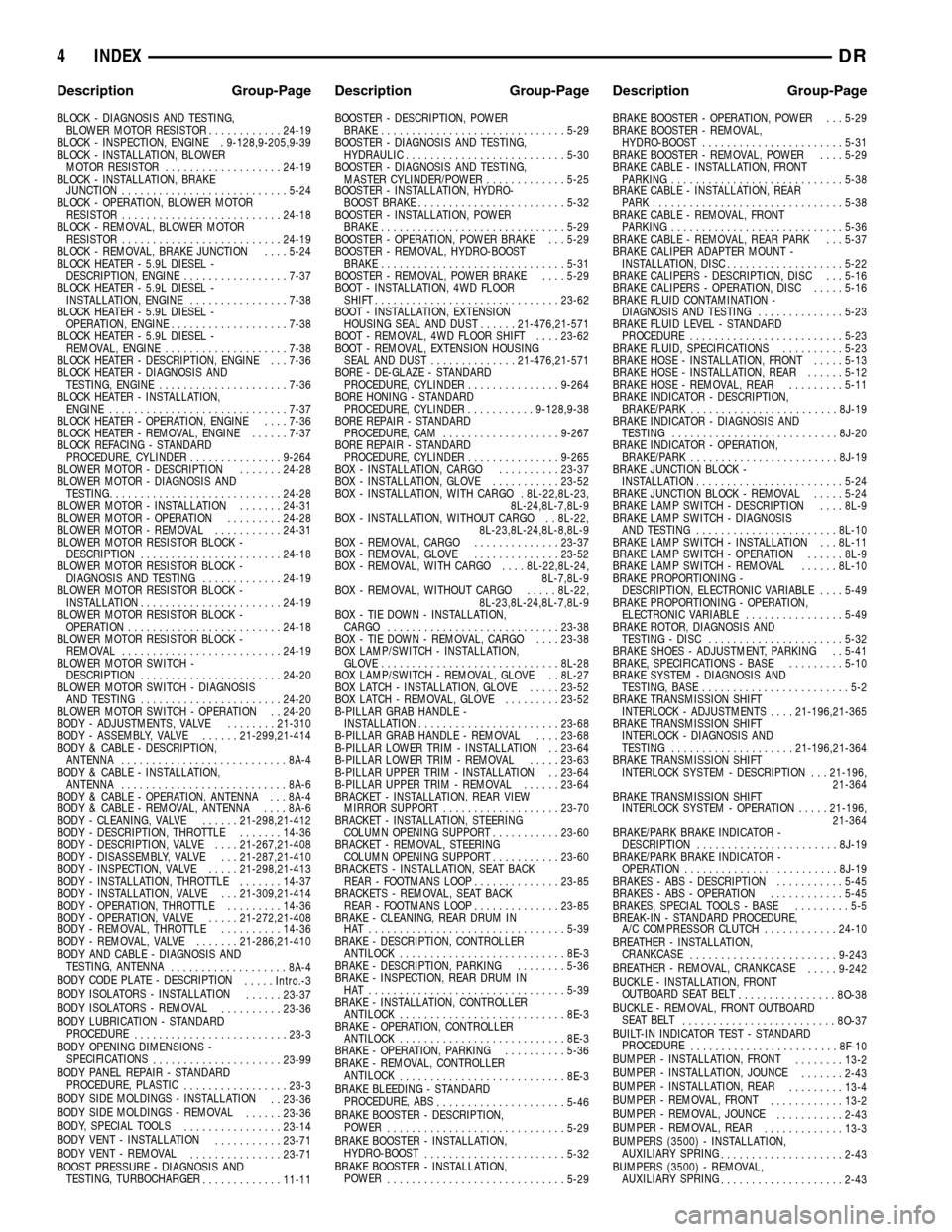
BLOCK - DIAGNOSIS AND TESTING,
BLOWER MOTOR RESISTOR............24-19
BLOCK - INSPECTION, ENGINE . 9-128,9-205,9-39
BLOCK - INSTALLATION, BLOWER
MOTOR RESISTOR...................24-19
BLOCK - INSTALLATION, BRAKE
JUNCTION...........................5-24
BLOCK - OPERATION, BLOWER MOTOR
RESISTOR..........................24-18
BLOCK - REMOVAL, BLOWER MOTOR
RESISTOR..........................24-19
BLOCK - REMOVAL, BRAKE JUNCTION....5-24
BLOCK HEATER - 5.9L DIESEL -
DESCRIPTION, ENGINE.................7-37
BLOCK HEATER - 5.9L DIESEL -
INSTALLATION, ENGINE................7-38
BLOCK HEATER - 5.9L DIESEL -
OPERATION, ENGINE...................7-38
BLOCK HEATER - 5.9L DIESEL -
REMOVAL, ENGINE....................7-38
BLOCK HEATER - DESCRIPTION, ENGINE . . . 7-36
BLOCK HEATER - DIAGNOSIS AND
TESTING, ENGINE.....................7-36
BLOCK HEATER - INSTALLATION,
ENGINE.............................7-37
BLOCK HEATER - OPERATION, ENGINE....7-36
BLOCK HEATER - REMOVAL, ENGINE......7-37
BLOCK REFACING - STANDARD
PROCEDURE, CYLINDER...............9-264
BLOWER MOTOR - DESCRIPTION.......24-28
BLOWER MOTOR - DIAGNOSIS AND
TESTING.............................24-28
BLOWER MOTOR - INSTALLATION.......24-31
BLOWER MOTOR - OPERATION.........24-28
BLOWER MOTOR - REMOVAL...........24-31
BLOWER MOTOR RESISTOR BLOCK -
DESCRIPTION.......................24-18
BLOWER MOTOR RESISTOR BLOCK -
DIAGNOSIS AND TESTING.............24-19
BLOWER MOTOR RESISTOR BLOCK -
INSTALLATION.......................24-19
BLOWER MOTOR RESISTOR BLOCK -
OPERATION.........................24-18
BLOWER MOTOR RESISTOR BLOCK -
REMOVAL..........................24-19
BLOWER MOTOR SWITCH -
DESCRIPTION.......................24-20
BLOWER MOTOR SWITCH - DIAGNOSIS
AND TESTING.......................24-20
BLOWER MOTOR SWITCH - OPERATION . . 24-20
BODY - ADJUSTMENTS, VALVE........21-310
BODY - ASSEMBLY, VALVE......21-299,21-414
BODY & CABLE - DESCRIPTION,
ANTENNA...........................8A-4
BODY & CABLE - INSTALLATION,
ANTENNA...........................8A-6
BODY & CABLE - OPERATION, ANTENNA . . . 8A-4
BODY & CABLE - REMOVAL, ANTENNA....8A-6
BODY - CLEANING, VALVE......21-298,21-412
BODY - DESCRIPTION, THROTTLE.......14-36
BODY - DESCRIPTION, VALVE....21-267,21-408
BODY - DISASSEMBLY, VALVE . . . 21-287,21-410
BODY - INSPECTION, VALVE.....21-298,21-413
BODY - INSTALLATION, THROTTLE.......14-37
BODY - INSTALLATION, VALVE . . . 21-309,21-414
BODY - OPERATION, THROTTLE.........14-36
BODY - OPERATION, VALVE.....21-272,21-408
BODY - REMOVAL, THROTTLE..........14-36
BODY - REMOVAL, VALVE.......21-286,21-410
BODY AND CABLE - DIAGNOSIS AND
TESTING, ANTENNA
...................8A-4
BODY CODE PLATE - DESCRIPTION
.....Intro.-3
BODY ISOLATORS - INSTALLATION
......23-37
BODY ISOLATORS - REMOVAL
..........23-36
BODY LUBRICATION - STANDARD
PROCEDURE
.........................23-3
BODY OPENING DIMENSIONS -
SPECIFICATIONS
.....................23-99
BODY PANEL REPAIR - STANDARD
PROCEDURE, PLASTIC
.................23-3
BODY SIDE MOLDINGS - INSTALLATION
. . 23-36
BODY SIDE MOLDINGS - REMOVAL
......23-36
BODY, SPECIAL TOOLS
................23-14
BODY VENT - INSTALLATION
...........23-71
BODY VENT - REMOVAL
...............23-71
BOOST PRESSURE - DIAGNOSIS AND
TESTING, TURBOCHARGER
.............11-11BOOSTER - DESCRIPTION, POWER
BRAKE..............................5-29
BOOSTER - DIAGNOSIS AND TESTING,
HYDRAULIC..........................5-30
BOOSTER - DIAGNOSIS AND TESTING,
MASTER CYLINDER/POWER.............5-25
BOOSTER - INSTALLATION, HYDRO-
BOOST BRAKE........................5-32
BOOSTER - INSTALLATION, POWER
BRAKE..............................5-29
BOOSTER - OPERATION, POWER BRAKE . . . 5-29
BOOSTER - REMOVAL, HYDRO-BOOST
BRAKE..............................5-31
BOOSTER - REMOVAL, POWER BRAKE....5-29
BOOT - INSTALLATION, 4WD FLOOR
SHIFT..............................23-62
BOOT - INSTALLATION, EXTENSION
HOUSING SEAL AND DUST......21-476,21-571
BOOT - REMOVAL, 4WD FLOOR SHIFT....23-62
BOOT - REMOVAL, EXTENSION HOUSING
SEAL AND DUST..............21-476,21-571
BORE - DE-GLAZE - STANDARD
PROCEDURE, CYLINDER...............9-264
BORE HONING - STANDARD
PROCEDURE, CYLINDER...........9-128,9-38
BORE REPAIR - STANDARD
PROCEDURE, CAM...................9-267
BORE REPAIR - STANDARD
PROCEDURE, CYLINDER...............9-265
BOX - INSTALLATION, CARGO..........23-37
BOX - INSTALLATION, GLOVE...........23-52
BOX - INSTALLATION, WITH CARGO . 8L-22,8L-23,
8L-24,8L-7,8L-9
BOX - INSTALLATION, WITHOUT CARGO . . 8L-22,
8L-23,8L-24,8L-8,8L-9
BOX - REMOVAL, CARGO..............23-37
BOX - REMOVAL, GLOVE..............23-52
BOX - REMOVAL, WITH CARGO....8L-22,8L-24,
8L-7,8L-9
BOX - REMOVAL, WITHOUT CARGO.....8L-22,
8L-23,8L-24,8L-7,8L-9
BOX - TIE DOWN - INSTALLATION,
CARGO............................23-38
BOX - TIE DOWN - REMOVAL, CARGO....23-38
BOX LAMP/SWITCH - INSTALLATION,
GLOVE.............................8L-28
BOX LAMP/SWITCH - REMOVAL, GLOVE . . 8L-27
BOX LATCH - INSTALLATION, GLOVE.....23-52
BOX LATCH - REMOVAL, GLOVE.........23-52
B-PILLAR GRAB HANDLE -
INSTALLATION.......................23-68
B-PILLAR GRAB HANDLE - REMOVAL....23-68
B-PILLAR LOWER TRIM - INSTALLATION . . 23-64
B-PILLAR LOWER TRIM - REMOVAL.....23-63
B-PILLAR UPPER TRIM - INSTALLATION . . 23-64
B-PILLAR UPPER TRIM - REMOVAL......23-64
BRACKET - INSTALLATION, REAR VIEW
MIRROR SUPPORT...................23-70
BRACKET - INSTALLATION, STEERING
COLUMN OPENING SUPPORT...........23-60
BRACKET - REMOVAL, STEERING
COLUMN OPENING SUPPORT...........23-60
BRACKETS - INSTALLATION, SEAT BACK
REAR - FOOTMANS LOOP..............23-85
BRACKETS - REMOVAL, SEAT BACK
REAR - FOOTMANS LOOP..............23-85
BRAKE - CLEANING, REAR DRUM IN
HAT ................................5-39
BRAKE - DESCRIPTION, CONTROLLER
ANTILOCK...........................8E-3
BRAKE - DESCRIPTION, PARKING........5-36
BRAKE - INSPECTION, REAR DRUM IN
HAT ................................5-39
BRAKE - INSTALLATION, CONTROLLER
ANTILOCK...........................8E-3
BRAKE - OPERATION, CONTROLLER
ANTILOCK...........................8E-3
BRAKE - OPERATION, PARKING..........5-36
BRAKE - REMOVAL, CONTROLLER
ANTILOCK
...........................8E-3
BRAKE BLEEDING - STANDARD
PROCEDURE, ABS
.....................5-46
BRAKE BOOSTER - DESCRIPTION,
POWER
.............................5-29
BRAKE BOOSTER - INSTALLATION,
HYDRO-BOOST
.......................5-32
BRAKE BOOSTER - INSTALLATION,
POWER
.............................5-29BRAKE BOOSTER - OPERATION, POWER . . . 5-29
BRAKE BOOSTER - REMOVAL,
HYDRO-BOOST.......................5-31
BRAKE BOOSTER - REMOVAL, POWER....5-29
BRAKE CABLE - INSTALLATION, FRONT
PARKING............................5-38
BRAKE CABLE - INSTALLATION, REAR
PARK...............................5-38
BRAKE CABLE - REMOVAL, FRONT
PARKING............................5-36
BRAKE CABLE - REMOVAL, REAR PARK . . . 5-37
BRAKE CALIPER ADAPTER MOUNT -
INSTALLATION, DISC...................5-22
BRAKE CALIPERS - DESCRIPTION, DISC . . . 5-16
BRAKE CALIPERS - OPERATION, DISC.....5-16
BRAKE FLUID CONTAMINATION -
DIAGNOSIS AND TESTING..............5-23
BRAKE FLUID LEVEL - STANDARD
PROCEDURE.........................5-23
BRAKE FLUID, SPECIFICATIONS..........5-23
BRAKE HOSE - INSTALLATION, FRONT.....5-13
BRAKE HOSE - INSTALLATION, REAR......5-12
BRAKE HOSE - REMOVAL, REAR.........5-11
BRAKE INDICATOR - DESCRIPTION,
BRAKE/PARK........................8J-19
BRAKE INDICATOR - DIAGNOSIS AND
TESTING...........................8J-20
BRAKE INDICATOR - OPERATION,
BRAKE/PARK........................8J-19
BRAKE JUNCTION BLOCK -
INSTALLATION.........................5-24
BRAKE JUNCTION BLOCK - REMOVAL.....5-24
BRAKE LAMP SWITCH - DESCRIPTION....8L-9
BRAKE LAMP SWITCH - DIAGNOSIS
AND TESTING.......................8L-10
BRAKE LAMP SWITCH - INSTALLATION . . . 8L-11
BRAKE LAMP SWITCH - OPERATION......8L-9
BRAKE LAMP SWITCH - REMOVAL......8L-10
BRAKE PROPORTIONING -
DESCRIPTION, ELECTRONIC VARIABLE....5-49
BRAKE PROPORTIONING - OPERATION,
ELECTRONIC VARIABLE................5-49
BRAKE ROTOR, DIAGNOSIS AND
TESTING - DISC......................5-32
BRAKE SHOES - ADJUSTMENT, PARKING . . 5-41
BRAKE, SPECIFICATIONS - BASE.........5-10
BRAKE SYSTEM - DIAGNOSIS AND
TESTING, BASE........................5-2
BRAKE TRANSMISSION SHIFT
INTERLOCK - ADJUSTMENTS....21-196,21-365
BRAKE TRANSMISSION SHIFT
INTERLOCK - DIAGNOSIS AND
TESTING....................21-196,21-364
BRAKE TRANSMISSION SHIFT
INTERLOCK SYSTEM - DESCRIPTION . . . 21-196,
21-364
BRAKE TRANSMISSION SHIFT
INTERLOCK SYSTEM - OPERATION.....21-196,
21-364
BRAKE/PARK BRAKE INDICATOR -
DESCRIPTION.......................8J-19
BRAKE/PARK BRAKE INDICATOR -
OPERATION.........................8J-19
BRAKES - ABS - DESCRIPTION...........5-45
BRAKES - ABS - OPERATION............5-45
BRAKES, SPECIAL TOOLS - BASE.........5-5
BREAK-IN - STANDARD PROCEDURE,
A/C COMPRESSOR CLUTCH............24-10
BREATHER - INSTALLATION,
CRANKCASE
........................9-243
BREATHER - REMOVAL, CRANKCASE
.....9-242
BUCKLE - INSTALLATION, FRONT
OUTBOARD SEAT BELT
................8O-38
BUCKLE - REMOVAL, FRONT OUTBOARD
SEAT BELT
.........................8O-37
BUILT-IN INDICATOR TEST - STANDARD
PROCEDURE
........................8F-10
BUMPER - INSTALLATION, FRONT
........13-2
BUMPER - INSTALLATION, JOUNCE
.......2-43
BUMPER - INSTALLATION, REAR
.........13-4
BUMPER - REMOVAL, FRONT
............13-2
BUMPER - REMOVAL, JOUNCE
...........2-43
BUMPER - REMOVAL, REAR
.............13-3
BUMPERS (3500) - INSTALLATION,
AUXILIARY SPRING
....................2-43
BUMPERS (3500) - REMOVAL,
AUXILIARY SPRING
....................2-43
4 INDEXDR
Description Group-Page Description Group-Page Description Group-Page